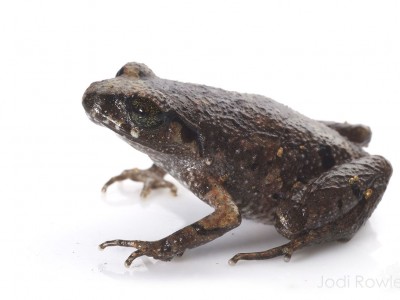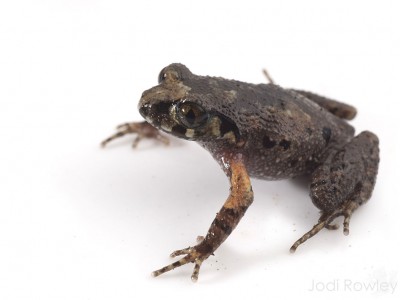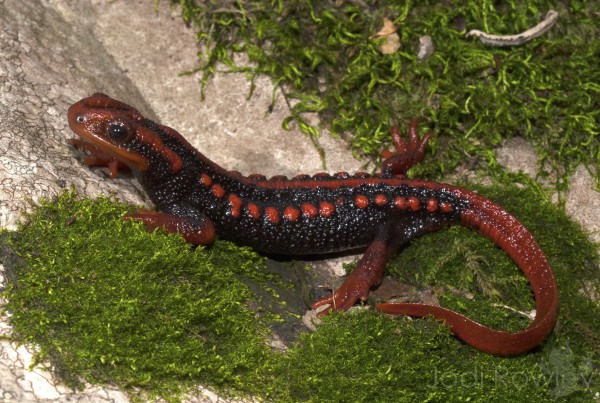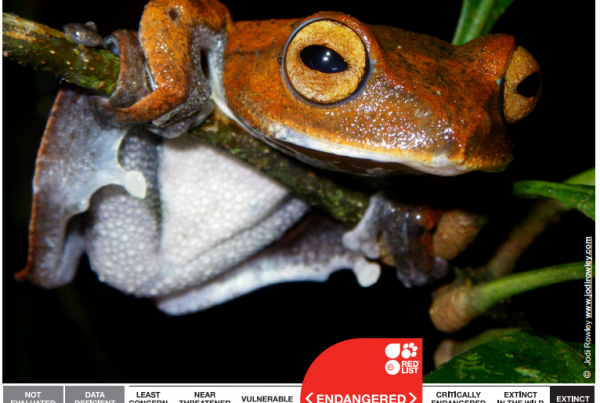Some frog species are really easy to tell apart. Take a large, green and smooth-skinned frog, and compare it to a small, grey, bumpy-skinned frog- they’re very unlikely to be the same species.
But some frog species are nearly impossible to discern from each other on looks alone.
If you’re a well-camouflaged, brownish frog that lives in the brownish leaves on the forest floor, it’s probably a good idea to stay small and brown, and not evolve into something that stands out to hungry predators. Partly for that reason, frogs can evolve over time into different species without dramatically changing their appearance.
Another reason that different frog species can look nearly identical is because frogs attract a mate primarily by their advertisement call. Instead of hopping around and looking for frogs that resemble them (or a better looking version of them) male frogs generally call to attract females from far and wide. Males of each species have distinct calls and females have ears tuned specifically to that call. It’s only once the female gets lured right up to a male by their call that their appearance, “dance moves” or pheromones come into play. So frogs are able to stick with the same look even after evolving into completely different species (there’s also unrelated frog species that have evolved into very similar appearances, but that’s another story).
Take Asian leaf-litter frogs (genus Leptolalax). As their name implies, they live in leaf-litter on the forest floor. Some of the smallest species in the group are only 2 cm (less than half an inch) in body length, small and brown and almost all the species are very, very similar to look at. So similar in fact, that I can’t even tell several species that I know very well apart in a photo. In order to identify what species I’m looking at, I’d have to look closely at their eye colour, hands and feet, and their belly pattern. I’d then likely have to measure their body length, head width and leg length.
I’m sure these frogs could just look at each other and instantly see the differences, but humans such as myself are obviously pretty poor at picking up the differences.

The colour and patterns of a frog eye can help reveal what species it is. The eye colouration of the Bidoup Leaf-litter Toads (Leptolalax bidoupensis; left) is one of the characteristics that distinguishes it from closely related species.
So if relying on appearances isn’t the most obvious way to identify these frogs, what is? DNA analysis really helps with identifying species. Large differences in the DNA of similar-looking species suggests that they may have evolving independently for a very long time, and are likely different species. Then there’s their calls- I’ve spent a fair bit of time sitting in the dark in the forests of Vietnam and Cambodia recording the calls of these little guys with professional recording equipment.
For a long time frogs like these little Leptolalax have been clumsily lumped by us humans into a handful of species. However, with more emphasis on DNA and call analysis, along with lots of detailed measurements, we’re only now just starting to discover that many frog “species” are actually groups of many frog species. We’ve just been getting them confused.
Being able to tell species apart can have important consequences. Many frog “species” that were thought to be under no threat of extinction because they were distributed over large areas are actually groups of related species that each occur in much smaller areas. Far from being safe from extinction, these frog species are often extremely vulnerable to habitat loss. So, unfortunately, the more we understand about frogs, the more cause of concern there is for their survival.
Identifying frog species is often about far more than just looks, and the differences can be extremely subtle. Thankfully us humans are getting better at picking up the differences.
Three species of Asian Leaf-litter Toad (Leptolalax). Can you tell them apart?







